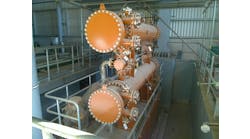A report issued in late May by the American Chemistry Council (ACC), Washington, D.C., foresees substantial job growth resulting from investments linked to the availability of low-cost shale gas. "Shale Gas, Competitiveness, and New U.S. Chemical Industry Investment: An Analysis Based on Announced Projects" examined the impact of 97 chemical and plastics projects announced through the end of March. They total $71.7 billion in capital spending.
[pullquote]
The majority of the projects involve expansion of production capacity for ethylene, ethylene derivatives (e.g., polyethylene and polyvinyl chloride), ammonia, methanol, propylene and chlorine, notes the report. Much of the investment targets the increasing of exports, which can help decrease the U.S. trade deficit, it adds.
According to the report, which is downloadable at http://chemistrytoenergy.com/shale-study, the projects could create 46,000 jobs in the chemical industry, another 264,000 in supplier industries, with spending by these workers leading to 226,000 more jobs in local communities — generating $20 billion in federal, state and local tax revenue. In addition, work on the projects could lead to 1.2 million temporary jobs through 2020, including 485,000 jobs in construction and process equipment manufacturing.
"The United States has become a magnet for chemical industry investment, a testament to the favorable environment created by America's shale gas as well as a vote of confidence in a bright natural gas outlook for decades to come," notes ACC president and CEO Cal Dooley. "What's especially exciting is that half of the announced investments are from firms based outside the United States, which means our country is poised to capture market share from the rest of the world." The large number of foreign chemical firms investing in the U.S. is unprecedented in recent history and underscores that nowhere else in the world is the outlook as bright when it comes to natural gas, says the report.
The buildup should continue beyond 2020. The report estimates that an additional $24.5–$29.5 billion in chemical industry investment could occur between then and 2025.
"Right now, the chemical industry has the confidence needed to drive new U.S. investment. Policymakers can help ensure that confidence continues for decades to come," the report emphasizes. Sustaining the manufacturing renaissance will require action on a variety of issues, it notes, including: access to oil and gas reserves on government and private lands, easing the permitting, siting and building of infrastructure linking oil and gas production to chemical manufacturing sites; and opening up more foreign markets to U.S. goods.
The benefits can extend well beyond the chemical industry, the report notes: "Further expansion of the nation's shale gas and ethane can drive an even greater expansion in domestic manufacturing capacity, provided that policymakers develop balanced regulatory policies and permitting practices."
This report is the third in a series on the potential economic benefits of shale gas. The first, "Shale Gas and New Petrochemicals Investment: Benefits for the Economy, Jobs, and U.S. Manufacturing," came out in March 2011 and looked at the impact of expanded petrochemicals production from a hypothetical 25% increase in ethane supply. The second, "Shale Gas, Competitiveness and New U.S. Investment: A Case Study of Eight Manufacturing Industries," followed in May 2012 and assessed the effect of lower natural gas prices and renewed competitiveness on the paper, chemicals, plastic and rubber products, glass, iron and steel, aluminum, foundries and fabricated metal products industries.

MARK ROSENZWEIG is Chemical Processing's Editor in Chief. You can e-mail him at [email protected]
Latest from Reliability & Maintenance
Latest from Reliability & Maintenance


